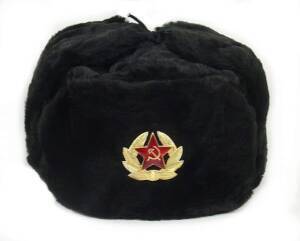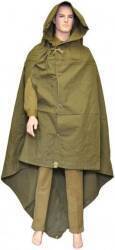
Military Surplus Ammunition Labels
Decoding Soviet Military Surplus Ammunition Labels
When you buy Soviet or Russian military surplus ammunition in "Spam cans" contained in wooden crates, you will find that the containers have cryptic labels. The markings clearly tell you about the bullet type, powder type, and year and place of manufacture, if you know how to decode the markings. Here is how to read Soviet military surplus ammunition labels.
Military surplus ammunition for classic Warsaw Pact weapons like the Mosin-Nagant or Kalashnikov usually comes in containers labeled in Russian using Soviet military nomenclature.
Here are two views of a wooden crate containing 7.62x54mmR ammunition. Once you know how to read the markings, you can clearly see that this crate contains 880 rounds of 7.62mm cartridges. The bullets are the standard military ball, not armor-piercing, tracer, or other even more exotic types.
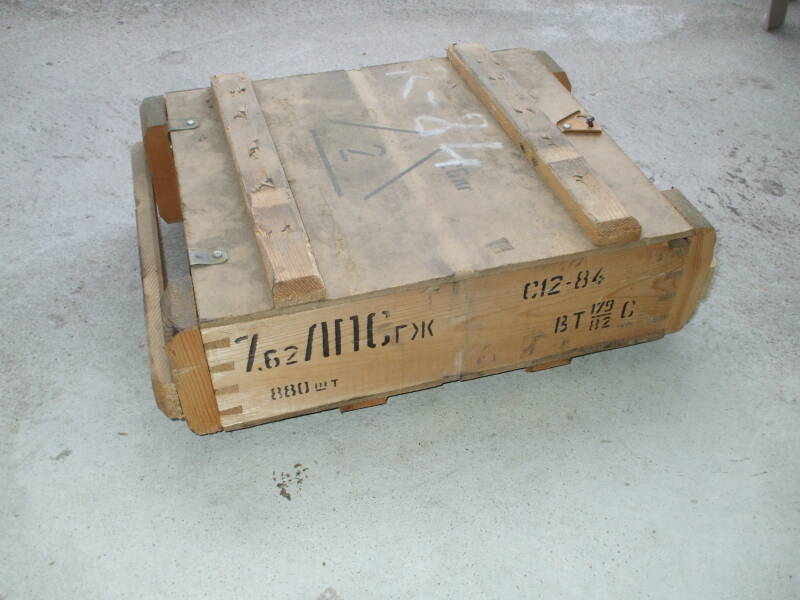
The large triangle with the "2" on the top surface is a cargo classification, right next to it is the total weight and КГ or "kg", for kilogram.
The white stickers are actually in Czech, with the lower one repeating the same content in English.
To the right are Брутто and Нетто, brutto and netto, or gross and net weight.
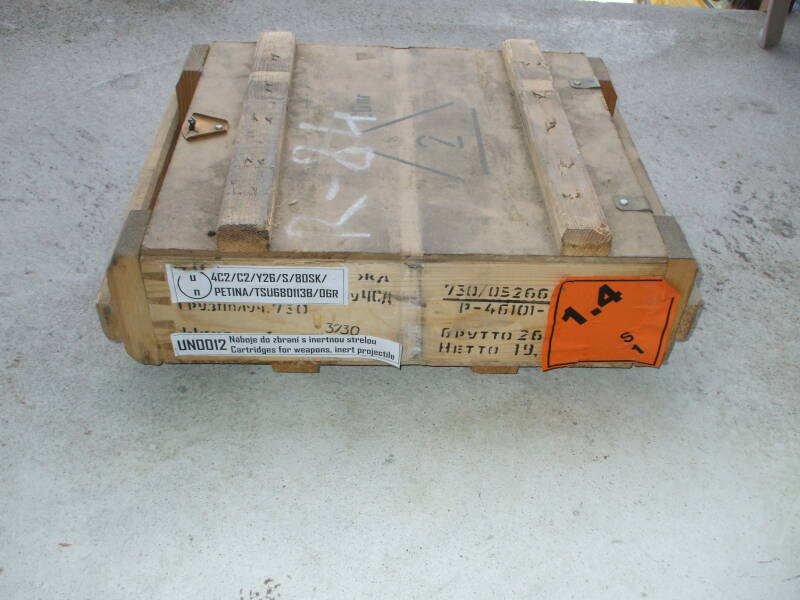
We will be able to tell more once we open the case and see the markings on the sealed metal cans. That will tell us:
The cartridge cases are the usual bimetallic cases, steel clad with "gilding metal".
How old? The powder was manufactured in 1977, the same year the cartridges were loaded.
Manufactured where? The powder was manufactured in Kemerovsk, and the cartridges were assembled in Novosibirsk, if that matters to you.
Inside the wooden crate are two green metal "Spam Can" containers, as shown here. Resting on top is the included can opener. These are Russian military surplus, or more precisely, Soviet given their vintage.
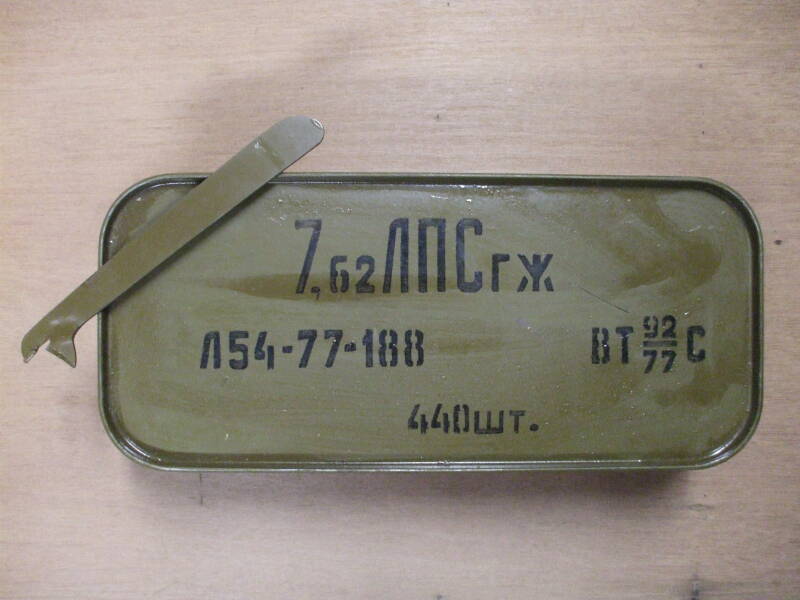
The short version is that ЛПС is equivalent to "military ball" in U.S. nomenclature, but...
Let's learn how to decode Soviet military surplus ammunition labels
What we see on the can:
7,62ЛПСГЖ
|
||||||
Л54-77-188
|
|
|||||
440ШТ.
|
||||||
What that means:
| Caliber / Bullet type / Case type | ||
|
Cartridge: Lot - Year - Factory |
Powder: Type Lot/Year Source |
|
| Quantity | ||
Let's start with the easy part.
7,62 specifies the caliber.
Like most Europeans, Russians use "," to indicate
the decimal point.
Next, almost as easy:
Did you notice that the wooden case was marked
880ШТ
and it contained two metal packages marked
440ШТ?
ШТ is short for штука or shtuka — item, thing or piece. Two 440-round cans go into one 880-round case.
As for the rest of the markings, here is what I have
figured out with the help of the
Russian-language Wikipedia
and two U.S. military training manuals,
TM 30-544 Russian Military Dictionary
and
TM 30-546 Glossary of Soviet Military and Related Abbreviations.
You may also want to ask Google to search for
a DIA document from August, 1984 with explanations
of headstamps and packaging for most if not all countries:
"small-caliber ammunition identification guide"
filetype:pdf
| Marking | Meaning |
7,62 |
Caliber |
ЛПС |
Bullet type |
ГЖ |
Case type |
Л54 |
Lot series & number |
77 |
Cartridge production year |
188 |
Factory |
ВТ |
Powder type |
92 |
Powder lot number |
77 |
Powder production year |
С |
Powder source |
440ШТ |
Quantity |
Realize that, of course, the Soviets used the Russian language's Cyrillic alphabet. In some cases, such as the letters А К, М, О and Т, our corresponding Latin character looks the same. But often, the Cyrillic only looks like a Latin one. For example, Cyrillic В is equivalent to Latin V, Cyrillic Н is equivalent to Latin N, and so on. Others, like Cyrillic Ж, И, Ш, Щ, Я and several others are unlike anything in the Latin alphabet. Here is a quick guide to the Cyrillic alphabet.
| Cyrillic | Latin | Cyrillic | Latin | |
| А | A | Р | R | |
| Б | B | С | S | |
| В | V | Т | T | |
| Г | G | У | U | |
| Д | D | Ф | F | |
| Е | YE | Х | KH | |
| Ж | ZH | Ц | TS | |
| З | Z | Ч | CH | |
| И | I | Ш | SH | |
| Й | Y | Щ | SHCH | |
| К | K | Ъ | — | |
| Л | L | Ы | IY | |
| М | M | Ь | ' | |
| Н | N | Э | EH | |
| О | O | Ю | YU | |
| П | P | Я | YA |
Now let's decode the rest of the ammunition case markings.
| Bullet Types | |
| Mark | Meaning |
| Б | Armor-piercing (also Б-30, Б-32) |
| БЗ | Armor-piercing incendiary |
| БЗТ | Armor-piercing incendiary tracer (also БЗТ-44) |
| БП | Armor-piercing |
| БС | Armor-piercing with special core of tungsten carbide instead of carbon steel (also БС-40, БС-41) |
| БСТ | Armor-piercing with tungsten carbide core with added tracer |
| БТ | Armor-piercing tracer |
| Д | Heavy (long-range) with lead core instead of carbon steel |
| З | Incendiary |
| ЗП | Incendiary |
| Л | Lightweight bullet |
| ЛПС | Light ball bullet with mild steel core |
| МДЗ | High explosive incendiary |
| П | Spotting / ranging (also П-41) |
| ПЗ | Incendiary spotting / ranging |
| ПП | Enhanced penetration |
| ПС | Ball round with mild steel core |
| ПТ | Spotting / ranging tracer |
| СНБ | Armor-piercing sniper |
| Т | Tracer (also Т-30, Т-45, Т-46) |
| 57-У-322 57-У-323 |
Cartridge with higher powder charge |
| 57-У-423 | High-pressure cartridge |
| 57-Х-322 57-Х-323 57-Х-340 |
Blank cartridge |
| 57-НЕ-УЧ | Training cartridge |
| 7Н1 | Sniper bullet |
7,62ЛПСГЖ
Caliber — Bullet type — Case type
7,62 means
7.62mm caliber.
ЛПС means Light ball bullet with mild steel core. An added two-digit number would indicate a bullet with a pattern introduced in that year. For example, Б-30 and Б-32 are armor-piercing bullet designed introduced in 1930 and 1932.
ГЖ = Bimetallic case. (steel case clad with gilding metal)
So,
7,62ЛПСГЖ
simply means it's 7.62mm light ball bullet
with mild steel core
(ЛПС)
in a gilded or copper-washed steel case
(ГЖ).
| Cartridge Cases | |
| Mark | Meaning |
| ГЖ | Bimetallic case (gilding metal clad steel) |
| ГЛ | Brass case |
| ГС | Steel case |
Л54-77-188
Lot series & number — year — Factory
Л54
simply means lot series Л54,
you would have to check with the factory records to figure
out what that really means.
The rest means that it was manufactured in 1977 at factory #188. That factory is in Novosibirsk (or Новосибирск) as this table tells us. The table is from the DIA "Small-Caliber Ammunition Identification Guide".
This table is for Russian factories. Other countries of manufacture will have their own codes. Bulgarian, for example, will have "10" in a double circle (and use БР as an abbreviation for "count" or "quantity").
The production year and factory number, 77 and 188, appear in the somewhat indistinct headstamp. That's a modern Russian commercial Bear cartridge at left, and one of the rounds from this surplus case at right.
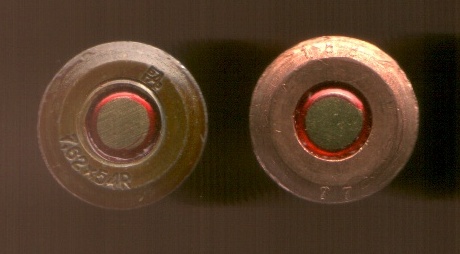
| Ammunition Factories | ||
| Code | Location | |
| 3 | Ulyanovsk | Уляновск |
| 17 | Barnaul | Барнаул |
| 38 | Yuryuzan | Юрюзань |
| 60 |
Frunze
(now Bishkek) |
Фрунзе |
| 188 | Novosibirsk | Новосибирск |
| 270 |
Voroshilovgrad
(now Luhansk) |
Ворошиловград |
| 304 | Lugansk | Луганськ |
| 539 | Tula | Тула |
| 711 | Klimovsk | Климоск |
| T | Tula | Тула |
| Powder | ||
| type | lot | factory |
| year | ||
| ВТ | 92 | С |
| 77 | ||
As for the powder type and source, as seen above, ВТ is the type, С is the source, and it's lot #92 from 1977. I have only limited information on how to interpret the type and source codes. I don't know what type ВТ is, but source С is the "Progress" factory of Kemerovsk.
I see a lot of confused postings in on-line forums where people think that ВТ means "Boat-Tail" bullet. Remember that these cans are labeled in the Cyrillic alphabet and so ВТ is equivalent to Latin VT! However, the frequency of this misunderstanding suggests that ВТ is a common powder type. I would guess that the В stands for винтовочный or vintovochniy, meaning "for rifles".
Powder types and factories
Powder type
ВУФЛ
—
Винтовочный
Уменьшенный
ФЛегматизированный
Пороха.
Small-grain phlegmatized gun powder.
A phlegmatizer is a material added to an
explosive to make it more stable, less susceptible
to detonation and safer to handle and transport.
ССНФ 30/3,97
—
Стрелкового
оружия
Сфероидная
—
Нитроглицерина
—
Флегматизатора.
Small arms spheroid — Nitroglycerin —
phlegmatized (stabilized)
30 = average size of grains in hundredths of millimeters;
that is an average grain size of 0.3 mm.
3,97 = average thermal energy developed, in MJ.
П-125 —
Пистолетные
пироксилиновых
пористые
пороха
трубчатой
формы
— 125.
Pyroxylized powder, porous tubular grains, for pistols.
Pyroxylin is a nitrocellulose compound soluble in
ether and alcohol.
125 = Quantity of nitrate incorporated to obtain porosity.
(used for blank rounds)
П-45 —
Пистолетные
пироксилиновых
пористые
пороха
трубчатой
формы
— 45.
Pyroxylized powder, porous tubular grains, for pistols.
45 = Quantity of nitrate incorporated to obtain porosity.
(used for subsonic rounds)
Powder factories
Don't count on this list being 100% complete or accurate. There is debate among specialists on the details of these. Factories used varying marks, sometimes (but not always) because the factories were renamed. Factory #577 in Solikamsk was established in 1941, then renamed Ural in 1966. Marks might be for a city name at times and the factory name at other times. "K" might indicate the city of Kazan, or maybe the S. M. Kirova factory in the city of Perm. Also see all the reorganization and renaming after the end of the Soviet Union, plus the spelling differences between Russian, Ukrainian, and Belorussian.
А — завод No100, Алексинский химический комбинат — Aleksinskiy khimecheskiy kombinat — Aleksinsky chemical plant.
Б — завод No577, Соликамский пороховой завод Урал — Solikamskiy porokhovoy zavod (1941), Solikamskiy zavod «Ural» (1966) — Solikamsk powder factory (1941), Solikamsk factory "Ural" (1966).
Е — завод No580, Красноярский завод Енисей — Krasnoyarskiy zavod «Yenisei» — Krasnoyarsk factory "Yenisei".
К — завод No98, Казанский пороховой завод — Kazanskiy porokhovoy zavod — Kazan powder factory. Or, К might indicate the Perm factory, which was named for С. М. Кирова (that is, S. M. Kirova) while С may mean the Kazan factory.
М — завод No98, Пермский пороховой завод — Permskiy porokhovoy zavod — Perm powder factory. Or possibly Kazan, see above.
Р — завод No101, Рошальский химкомбинат — Roshal'skiy khimkobinat — Roshal chemical factory.
С — Кемеровский завод Прогресс — Kemerovskiy zavod «Progress» — "Progress" factory of Kemerovsk. Or possibly Kazan, see above.
Т — завод No204, Тамбовский пороховой завод — Tambovskiy porokhovoy zavod — Tambov powder factory.
Ш — завод No9, Шксткинский завод Звезда — Shostkinskiy zavod «Zvezda» — Shostkinsk factory "Star".
ШЛ — завод No6, Морозовский химический завод — Morozovskiy khimicheskiy zavod — Morozovskiy chemical factory. It was designated ШЛ because it had earlier been the Шлиссельбургский or Shlissel'burgsky powder factory.
Ю — Гос. НИИХП, г. Казань — Гаучно-Исследовательский Институт Химических Продуктов — Gosudarstbenniy Nauchno-Issledovatel'skiy Institute Ximicheskikh Produktov, gorod Kazan' — State Scientific-Research Institute of Chemical Products, of the city of Kazan.
What about stripper clips?
I was contacted by someone wanting to make a highly accurate replica of an SKS ammunition crate. They wondered how "with stripper clips" might appear.
The dictionaries I have are for U.S. use, and so their Russian-to-English sections are significantly larger than the English-to-Russian section. "Clip" as it relates to ammunition was limited to a single entry for "magazine" in the English-to-Russian section, as in that part of a gun or else a detachable box magazine.
But then he found an illustration in the book Kalashnikov: The Arms and the Man: a Revised and Expanded Edition of the AK47 Story, by Edward Clinton Ezell (Cobourge, Ontario, Canada), 2001.
The phrase is "in" rather than "with" clips. Once I had what looked like the relevant word, sure enough, I could find it in the Russian-to-English section of a dictionary!
ВОБОИМАХ the illustration shows. There needs to be a space after the В or "in", and ideally a diacritical mark over a later letter. Military crates might omit the mark and use И instead of Й, expecting a native speaker to figure it out.
But, ideally, "in (stripper) clips" would be:
В ОБОЙМАХ
Transliterated for an English speaker to pronounce it:
V' oboymakh
More information?
Philippe Lafargue has written two fantastic references to the 7.69x39mm round as manufactured and packaged by Russia and by China. There's also a discussion on an SKS files forum.
Related pages on this site
The Mosin-Nagant
"3-Line" Rifle
Russian Military Nomenclature
for 9x18mm Handgun Ammunition
7.62x54mmR
Ammunition
7.62x39mm
Ammunition
